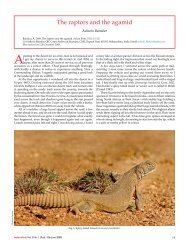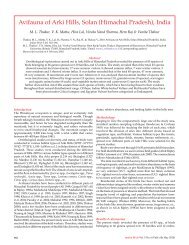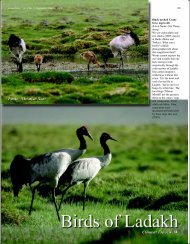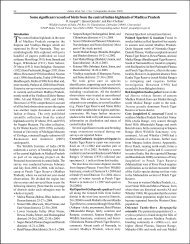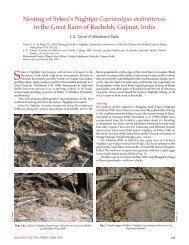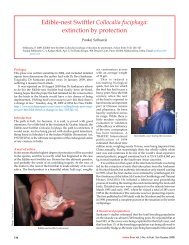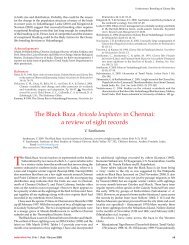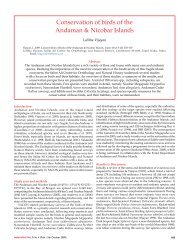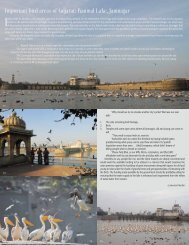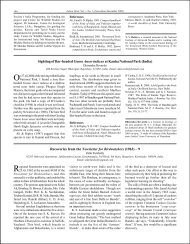Nesting of Caspian Tern Sterna caspia in Little Rann ... - Indian Birds
Nesting of Caspian Tern Sterna caspia in Little Rann ... - Indian Birds
Nesting of Caspian Tern Sterna caspia in Little Rann ... - Indian Birds
Create successful ePaper yourself
Turn your PDF publications into a flip-book with our unique Google optimized e-Paper software.
Pomal & Sevak: <strong>Caspian</strong> <strong>Tern</strong> 10171º8’57.30”E), on which the <strong>Caspian</strong> <strong>Tern</strong>s were recorded breed<strong>in</strong>g,is c. 3 km south <strong>of</strong> Nanda bet on the northern fr<strong>in</strong>ge <strong>of</strong> the<strong>Little</strong> <strong>Rann</strong> <strong>of</strong> Kachchh (Fig. 1). The bet is about 19 km west <strong>of</strong>where Ranjits<strong>in</strong>h (1992) had found eggshells, and dead chicks <strong>of</strong><strong>Caspian</strong> <strong>Tern</strong>, <strong>in</strong> December 1988 (Tiwari et al. 1997).ObservationsFrom Nanda bet, Bhikha Bhagat watched <strong>Caspian</strong> <strong>Tern</strong>s carry<strong>in</strong>gfish <strong>in</strong> their beaks (Fig. 2) and regularly fly<strong>in</strong>g southwards <strong>in</strong> earlySeptember 2009. Based on his earlier experience, he knew thatthis <strong>in</strong>dicated an active breed<strong>in</strong>g colony. When AP telephonedhim on 16 September 2009, he was actually on his way tolocate the breed<strong>in</strong>g colony and he was quite sure about f<strong>in</strong>d<strong>in</strong>gthe same. Excited by this news, we confirmed from Bhagatabout nest<strong>in</strong>g colony <strong>of</strong> <strong>Caspian</strong> <strong>Tern</strong> and decided to visit the sitewith other birdwatcher friends (Narendra Gor, D<strong>in</strong>esh Panchal,Bhavesh). On 17 September, we travelled about 200 km andreached Bhagat’s residence <strong>in</strong> Nanda bet at 2000 hrs. After adelicious traditional d<strong>in</strong>ner, we stargazed up to 0130 hrs. Theamaz<strong>in</strong>g sky was brilliant with stars, milky-ways and the occasionalpass<strong>in</strong>g <strong>of</strong> small meteorites.Next morn<strong>in</strong>g we awoke at 0500 hrs and got ready for themission under the leadership <strong>of</strong> Bhikha Bhagat. As per his <strong>in</strong>structions,we carried snacks, water, camera, and b<strong>in</strong>oculars. Wehad to walk about 3 km <strong>in</strong> three feet <strong>of</strong> water (Fig. 3) to reach toKhijadia bet. Before start<strong>in</strong>g, we saw Whiskered <strong>Tern</strong> Chlidoniashybridus—12, Lesser Sand Plover Charadrius mongolus—15, andKentish Plover C. alexandr<strong>in</strong>us—8, on Nanda bet. We saw hugerafts <strong>of</strong> ducks on our way. We did not realise how tir<strong>in</strong>g our tripwas for about one kilometer, for we were busy with photography.But after that AP had to give his camera bag to Bhikha Bhagat,who encouraged us to walk slowly. After about two kilometers, wewere much fatigued, but could see Khijadia bet. A few <strong>Caspian</strong><strong>Tern</strong>s fly<strong>in</strong>g around <strong>in</strong>spired us to walk the rema<strong>in</strong><strong>in</strong>g distance.We reached the western edge <strong>of</strong> Khijadia bet at 0845 hrs.This bet was c. 200x50 m <strong>in</strong> size, and was raised slightly abovewater. We could see about 125 <strong>Caspian</strong> <strong>Tern</strong>s and 100 Whiskered<strong>Tern</strong>s fly<strong>in</strong>g and call<strong>in</strong>g on the eastern edge <strong>of</strong> the bet.We also saw <strong>Caspian</strong> <strong>Tern</strong>s feed<strong>in</strong>g their young. Many <strong>of</strong> theWhiskered <strong>Tern</strong>s were <strong>in</strong> breed<strong>in</strong>g plumage but there was noevidence <strong>of</strong> them breed<strong>in</strong>g. The atmosphere was alive due totheir constant chirp<strong>in</strong>g.We counted 64 nests <strong>in</strong> the colony, which was spread onthe eastern part <strong>of</strong> the bet. The distance between two nests washardly 30–45 cm, and the distance <strong>of</strong> nests from the water wasjust 45–60 cm. The nest was a depression <strong>in</strong> the soil, 10 cm <strong>in</strong>diameter and two centimeters <strong>in</strong> depth, without any nest material.<strong>Birds</strong> were <strong>in</strong>cubat<strong>in</strong>g on <strong>in</strong> six nests, conta<strong>in</strong><strong>in</strong>g one egg each.Fig. 3. Members <strong>of</strong> the Kachchh Nature Club on their way fromNanda to Khijadia on 18 September 2009.Shell remnants <strong>of</strong> 62 eggs were found. Eggs, c. 5 cm long, had agreyish ground colour, with brown and black spots <strong>of</strong> variable sizeon their broad ends (Fig. 4). A few eggs were ly<strong>in</strong>g on ground;some <strong>of</strong> them were partly damaged. Six chicks were ly<strong>in</strong>g dead<strong>in</strong> the colony. We saw 45 chicks with dist<strong>in</strong>ct plumage and red bill<strong>in</strong> two groups, each <strong>of</strong> 20–25 <strong>in</strong>dividuals, swimm<strong>in</strong>g <strong>in</strong> the water(Fig. 5). The chicks may have been about 20–25 days old. Theterns were constantly fly<strong>in</strong>g overhead, utter<strong>in</strong>g their alarm callswhile we exam<strong>in</strong>ed the colony.At 1000 hrs we started for Sukhpar bet, reach<strong>in</strong>g it at 1200hrs, after walk<strong>in</strong>g 2 km. We had left our shoes on Nanda bet,and the hot soil gave us a try<strong>in</strong>g time. Moreover, our supply <strong>of</strong>dr<strong>in</strong>k<strong>in</strong>g water was almost f<strong>in</strong>ished. We still had to walk 3 km, onhard ground, to reach our dest<strong>in</strong>ation. The ground was burn<strong>in</strong>ghot and walk<strong>in</strong>g on grass was risky as there were lots <strong>of</strong> spikes.Somehow, manag<strong>in</strong>g between those two options, we reachedour dest<strong>in</strong>ation at 1345 hrs. After lunch at Bhikha Bhagat’s residence,we returned to Bhuj <strong>in</strong> the even<strong>in</strong>g.DiscussionBreed<strong>in</strong>g season: Go<strong>in</strong>g by the age <strong>of</strong> the chicks (20–25 days)that we saw on Khijadiya bet, and keep<strong>in</strong>g <strong>in</strong> m<strong>in</strong>d the on go<strong>in</strong>g<strong>in</strong>cubation at six nests (9.4%), we assume that the majority <strong>of</strong>chicks might have hatched <strong>in</strong> the last week <strong>of</strong> August 2009. If20–22 days were the <strong>in</strong>cubation period (Ali & Ripley 1983), theprobable period <strong>of</strong> the colony’s development would be aroundmid-July. Hence, on Khijadia bet, the <strong>Caspian</strong> <strong>Tern</strong>s bred dur<strong>in</strong>gJuly–September 2009. Tiwari et al. (1997) had recorded theirnest<strong>in</strong>g on Khijadia bet dur<strong>in</strong>g November–December. Tiwari etal. (1997) op<strong>in</strong>ed that precise time <strong>of</strong> nest<strong>in</strong>g appears to beprimarily controlled by the appearance <strong>of</strong> temporary islands fornest<strong>in</strong>g, which <strong>in</strong> turn are dependent on the flood<strong>in</strong>g regime <strong>of</strong>the <strong>Rann</strong>. The terns could breed dur<strong>in</strong>g south-west monsoon,probably because <strong>of</strong> below average annual precipitation result<strong>in</strong>g<strong>in</strong>to m<strong>in</strong>imum fluctuations <strong>in</strong> flood<strong>in</strong>g regime around theisland.Photos: Ashw<strong>in</strong> PomalFig. 2. <strong>Caspian</strong> <strong>Tern</strong> with fish.Fig. 4. Eggshell <strong>of</strong> <strong>Caspian</strong> <strong>Tern</strong>
102<strong>Indian</strong> <strong>Birds</strong> Vol. 6 Nos. 4&5 (Publ. 20 November 2010)Ashw<strong>in</strong> PomalFig. 5. <strong>Caspian</strong> <strong>Tern</strong> adults and young.The breed<strong>in</strong>g season <strong>of</strong> the <strong>Caspian</strong> <strong>Tern</strong> recorded on Khijadiabet is quite different from the Charakla saltpans (May–June)<strong>of</strong> Jamnagar district, Gujarat (Bhatia 2004). It is June-July <strong>in</strong> Pakistan(Roberts 1991–1992), and between May and June <strong>in</strong> SriLanka (Ali & Ripley 1983).Population size: On 18 September 2009, we counted64 nest depressions, and 150 adult <strong>Caspian</strong> <strong>Tern</strong>s around thecolony at Khijadiya bet. This is much less than the number <strong>of</strong>nests / pairs recorded breed<strong>in</strong>g on the same bet by Tiwari et al.(1997) <strong>in</strong> 1993 (200 nests), and 1994 (300 nests). At CharaklaSaltpans, Bhatia (2004) recorded 452 nests <strong>in</strong> June 2003, and1,600 adult terns on the colony <strong>in</strong> July 2003.AcknowledgementsBhikha Bhagat had discovered this colony <strong>in</strong> 1993 and had shown it toJ. K. Tiwari, S. N. Varu, and P. Majithia (Sanctuary Super<strong>in</strong>tendent, WildAss Sanctuary). After sixteen years, he has discovered breed<strong>in</strong>g colony <strong>of</strong>Caspa<strong>in</strong> <strong>Tern</strong>s at the same place and we feel proud to be witness <strong>of</strong> thissecond breed<strong>in</strong>g record <strong>in</strong> the <strong>Little</strong> <strong>Rann</strong> <strong>of</strong> Kachchh. We are thankful toR. L. Meena (Conservator Forest, Kachchh Circle), J. G. Bava (Dy. ConservatorForests, Wild Ass Sanctuary), L. N. Jadeja (Dy. Conservator Forests,Eastern Kachchh), J. D. Godhia (Range Forest Officer, Adesar), and J. K.Tiwari (CEDO) for special <strong>in</strong>formation. I especially thank B. M. Parasharyafor encourag<strong>in</strong>g us to publish this <strong>in</strong>formation by prepar<strong>in</strong>g this note andadd<strong>in</strong>g relevant discussion and references on the subject.ReferencesAli, S., & Ripley, S. D., 1983. Handbook <strong>of</strong> the birds <strong>of</strong> India and Pakistantogether with those <strong>of</strong> Bangladesh, Nepal, Bhutan and SriLanka. Compact ed. Delhi: Oxford University Press.Bhatia, Y., 2004. The <strong>Caspian</strong> <strong>Tern</strong>s <strong>of</strong> Jamnagar. Sanctuary Asia XXIV(4): 24–29.Grimmett, R., Inskipp, C., & Inskipp, T., 1998. <strong>Birds</strong> <strong>of</strong> the <strong>Indian</strong> Subcont<strong>in</strong>ent.1st ed. London: Christopher Helm, A & C Black.Kazmierczak, K., 2000. A field guide to the birds <strong>of</strong> India, Sri Lanka,Pakistan, Nepal, Bhutan, Bangladesh and the Maldives. 1st ed.New Delhi: Om Book Service.Ranjits<strong>in</strong>h, M. K., 1992. Breed<strong>in</strong>g <strong>of</strong> <strong>Caspian</strong> <strong>Tern</strong> Hydroprogne <strong>caspia</strong> <strong>in</strong>the <strong>Little</strong> <strong>Rann</strong> <strong>of</strong> Kutch, Gujarat. J. Bombay Nat. Hist. Soc. 88 (2):283–284.Rasmussen, P. C., & Anderton, J. C., 2005. <strong>Birds</strong> <strong>of</strong> South Asia: theRipley guide. 2 vols. 1st ed. Wash<strong>in</strong>gton, D.C. and Barcelona: SmithsonianInstitution and Lynx Edicions.Roberts, T. J., 1991–1992. The birds <strong>of</strong> Pakistan. 2 vols. Karachi: OxfordUniversity Press.Tiwari, J. K., Mundkur, T., Varu, S. N., & Majethia, P., 1997. Furtherevidence <strong>of</strong> <strong>Caspian</strong> <strong>Tern</strong> <strong>Sterna</strong> <strong>caspia</strong> breed<strong>in</strong>g <strong>in</strong> north–westernIndia. Newsletter for Birdwatchers 36 (6): 107–110.Bird<strong>in</strong>g adventures<strong>in</strong> Kachchh, GujaratRamki SreenivasanSreenivasan, R., 2010. Bird<strong>in</strong>g adventures <strong>in</strong> Kachchh, Gujarat. <strong>Indian</strong> BIRDS 6 (4&5): 102–105.Ramki Sreenivasan, 113, TIME, 6th Cross, Indiranagar, Bangalore 560038, Karnataka, India.Email: frogmouth@gmail.com.Dry earth, KachchhRamki SreenivasanFor the third time <strong>in</strong> three m<strong>in</strong>utes, the jeep sp<strong>in</strong>s 360 degrees<strong>in</strong> the slithery mud. I try, with m<strong>in</strong>imal results, to stayas calm as Lakkubhai, the veteran driver <strong>of</strong> our ‘Sumo’ SUV.Outside, the ra<strong>in</strong> cont<strong>in</strong>ues to pour <strong>in</strong> sheets, convert<strong>in</strong>g the entireterra<strong>in</strong> <strong>in</strong>to slurry. Though such storms are not common <strong>in</strong>Kachchh, they still constitute the bulk <strong>of</strong> the ra<strong>in</strong>fall, <strong>in</strong> this semidesertenvironment, dur<strong>in</strong>g the monsoon.Matters were a world apart that morn<strong>in</strong>g <strong>of</strong> 1 September2008, when we had set out for the Banni grasslands—at 3,847kms 2 , the largest expanse <strong>of</strong> flat land <strong>in</strong> the country. The dayhad started as a beautiful, sunny one till mid-afternoon. We wereslurp<strong>in</strong>g the last <strong>of</strong> the tea from saucers, they don’t do cups <strong>in</strong>Kachchh, when the western horizon suddenly turned an om<strong>in</strong>ousshade <strong>of</strong> grey-brown. We hurriedly returned the tea-ware to thenomadic camel herder who had, so k<strong>in</strong>dly, brewed fresh camelmilktea for us, and made an undignified dash for the jeep.Earlier over lunch, Jugal Tiwari, our bird-guide, had warned,“If it ra<strong>in</strong>s <strong>in</strong> the Banni, then we’re truly stuck. There are no roadshere and the soil quickly turns <strong>in</strong>to slush.” As the skies cont<strong>in</strong>uedto darken, we were well aware that the closest metalled road wasprobably 40–50 kms away. Jugalbhai hurried us on, and thoughwe implicitly trusted his <strong>in</strong>tuitive knowledge <strong>of</strong> the land, some-



